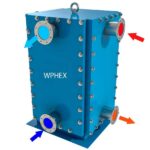How to calculate the Overall Heat Transfer Coefficient?
Heat exchanger setup typically involves two flowing fluids separated by a solid wall. Heat is first transferred from the hot fluid to the wall by convection, the heat is then transferred through the wall by conduction, and lastly the heat is transferred from the wall to the cold fluid again by convection. Any radiation effects are usually included in the convection heat transfer coefficients.
The thermal resistance network associated with this heat transfer process involves two convection and one conduction resistances.
This is mainly the fundamentals behind the deduction of the overall heat transfer coefficient. This article will not go into deducing all the equations behind how the thermal resistances network associated would result in the overall heat transfer coefficient equations.
Calculating the Overall Heat Transfer Coefficient in heat exchangers
The main objective in the design of a heat exchanger is to determine the surface area required for the specified duty (rate of heat transfer) using the temperature differences available. The overall heat transfer coefficient is the reciprocal of the overall resistance to heat transfer, which is the sum of several individual resistances as described earlier.
The overall heat transfer coefficient for clean and fouled surfaces based on the outside surface area of a tube can be calculated from the following equations,
Equations
Clean Overall heat transfer coefficient (for a new heat exchanger) – Equation 1A,

And
Design Overall heat transfer coefficient (Fouled conditions) – Equation 2A,

Where (in SI Units);
Uc = the clean overall heat transfer coefficient based on the outside area of the tube, assuming no fouling (new heat exchanger), W/m2 oK,
Ud = the design overall heat transfer coefficient based on the outside area of the tube taking into account fouling factors for both fluids, W/m2 oK,
ho = outside fluid film coefficient, W/m2 oK,
hi = inside fluid film coefficient, W/m2 oK,
Ro = outside dirt coefficient (fouling factor), m2°K/W
Ri = inside dirt coefficient (fouling factor), m2°K/W
do = outside diameter of tube, m
di = inside diameter of tube, m
The equations can also be written as below:
Clean Overall heat transfer coefficient (for a new heat exchanger) – Equation 1B,

And
Design Overall heat transfer coefficient (Fouled conditions) – Equation 2B,

Where (English/US Units);
Uc = the clean overall heat transfer coefficient based on the outside area of the tube, assuming no fouling (new heat exchanger), Btu/h.ft2 oF,
Ud = the design overall heat transfer coefficient based on the outside area of the tube taking into account fouling factors for both fluids, Btu/h.ft2 oF,
ho = outside fluid film coefficient, Btu/h.ft2 oF,
hi = inside fluid film coefficient, Btu/h.ft2 oF,
Ro = outside dirt coefficient (fouling factor), h.ft2°F/Btu
Ri = inside dirt coefficient (fouling factor), h.ft2°F/Btu
do = outside diameter of tube, ft
di = inside diameter of tube, ft
The magnitude of the individual coefficients will depend on the nature of the heat transfer process (conduction, convection, condensation, boiling or radiation), also on the physical properties of the fluids, on the fluid flow-rates, and on the physical arrangement of the heat-transfer surface. When the area is know the physical layout of the exchanger can be determined. The design of an exchanger is a trial and error procedure.
Design calculations are generally made on basis of fouled conditions as it’s necessary that the exchanger is operable after fouling has occurred.
You should also note that when calculating the overall heat transfer coefficient for the clean (new) exchanger conditions in comparison to design fouled conditions the value of the new coefficient should always be higher than the fouled conditions, this point is rather common sense and that’s why in all heat exchanger design calculations it’s very important to worry more about the fouled conditions and compare it to the required overall heat transfer coefficient.
How to influence the overall heat transfer coefficient calculation?
Generally speaking, if you are working on a design you would normally end up in a situation where your overall heat transfer coefficient for fouled conditions is not in range of your required overall heat transfer coefficient. In thermal analysis of shell and tube heat exchangers your would want to have your overall heat transfer coefficient for fouling conditions greater than or equal to the required value. This would indicate that the exchanger is thermally suitable to meet your requirements. Having said that, you should also make sure that the values in question are within acceptable limits, say 30%, so that you don’t over design the exchanger.
We can normally influence the calculations by:
- Adjusting tube dimensions (tube inside diameter and tube outside diameter)
- Changing the material of construction
- Changing Nusselt correlation. This influence the calculation for the inside and outside film heat transfer coefficients. We may need to do this if we don’t have actual values for the heat transfer coefficients and need to calculate both.
References:
- Robert W. Serth, Thomas G. Lestina, Process heat transfer principles, applications and rules of thumb, Second edition 2014, Elsevier Inc.
- Sadik Kakac, Hongtan Lui, Heat Exchangers selection, rating, and thermal design, Second edition 2002, CRC Press
Recommended software:
Shell and tube heat exchanger design (S&THex)
Shell and tube Condenser design (CnD)
Double pipe heat exchanger design (DHex)
Air cooled heat exchanger design (ACHex)
Gasketed plate heat exchanger design (PHex)










